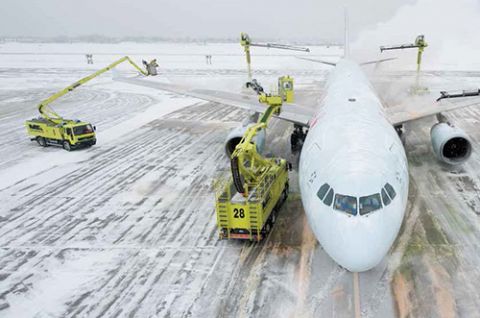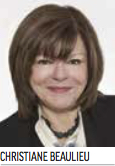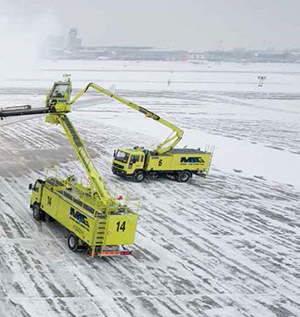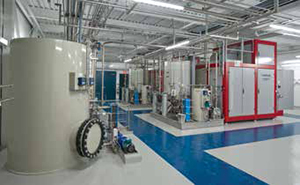Trudeau Int'l Invests in Deicing Services and Glycol Recycling Facilities

Montreal-Pierre Elliott Trudeau International Airport (YUL) has spent the past two decades honing its aircraft deicing operations into a centrally located eight-pad facility that recycles and reuses spent deicing fluids. It also transitioned to using a single common-use service provider. Together, the two entities have invested approximately $61 million since 1997 to improve the safety, efficiency, cost effectiveness and environmental sustainability of deicing operations at the Quebec airport.
"Aero Mag is more a partner with the airport than simply a service provider," qualifies Christiane Beaulieu, YUL's vice president of Public Affairs and Communications. "Over the years, we have perfected the system."
A couple decades ago, airport officials understood that YUL's deicing operations were neither ecologically responsible nor sustainable, she elaborates. Taking the bull by the horns, the airport partnered with Aero Mag to construct five deicing bays, an underground system to collect glycol and a central facility to store used glycol. The $40 million investment was "huge at the time," notes Beaulieu.
 facts&figures facts&figuresProject: Aircraft Deicing & Glycol Recovery/Recycling Location: Montreal-Pierre Elliott Trudeau Int'l Airport Sole Service Provider & Facility Management: Aero Mag Total Cost: $61 million 1997 Construction: 5-bay deicing pad & glycol recovery drains 2012 Construction: 3 additional pads 2013-14 Construction: Glycol recycling facility Funding: Airport capital improvement funds; Aero Mag Staffing: 3 operations managers; 3 supervisors; 120+ seasonal employees Maximum Capacity: 48 aircraft/hour Aircraft Deiced: 9,100 (2015-16) Deicing Fluids Applied: 6.45 million liters (2015-16) Glycol Recycling Center Design & Construction: Aero Mag Recycled Glycol Certification: LNT Solutions Deicing Vehicles: Vestergaard Co. (14 Elephant Beta; 10 Elephant MY) Glycol Distillation Equipment: Vilokan-Sweden Glycol Recovery Vehicle: Beam (A8000) Beam Distributor: Fortbrand Services Awards: Finalist Mercuriades 2015 & 2016, Quebec Chamber of Commerce; Accolades 2015, West Island Montreal Chamber of Commerce; Environmental Merit 2016 for I'm On Board Program, Montreal Airport-ADM; Safety/Security 2016 for I'm On Board Program, Montreal Airport-ADM; Environmental Award 2000, ADM; EY Entrepreneur of the Year 2015 award in Quebec clean-tech category Of Note: First airport in world to achieve a 99.5% concentration of recycled glycol for certified reuse as aircraft deicing fluid |
Efforts continued in 2012, when YUL invested an additional $11 million to add three more deicing bays. In 2013-14, Aero Mag and the airport added a $10 million state-of-the-art facility that recycles ethylene glycol for reuse at the airport. Using sophisticated methods, the facility purifies and concentrates used glycol for certified reuse at the airport. In doing so, YUL became the first airport in the world to recycle used deicing fluid at a minimum of 99.5% glycol concentration for subsequent aircraft deicing operations.
While the capital investments have been substantial, the benefits to YUL's airlines and the environment are significant, reflects Beaulieu. In addition to improving safety and efficiency as aircraft move through the deicing process and onto runways for departure, the system has reduced YUL's use of potable water by 2 million liters a year and lowered ethylene glycol costs for airlines by up to 30%.
Not surprisingly, the system is studied and admired by airport operators throughout the world.
Cost & Environmental Considerations
YUL takes a very aggressive approach regarding environmental initiatives, emphasizes Sam Charbel, Aero Mag's regional director for Eastern Canada. From the beginning, airport officials were intent on moving deicing operations away from the terminal gates and capturing spent glycol and water, he explains. The system in place today collects used glycol and water through an underground drainage network and stores it in five tanks capable of holding 227,300 liters each.
Recovered fluids are segmented for storage according to glycol concentration, and then run through a two-step refining process. During the first step, the system removes impurities such as jet fuel, oil, dirt and gravel from the deicing pad surface that were collected with spent fluids, and the remaining liquid is processed to achieve a 50/50 mix of glycol and water.
During the second step, the reconcentrated glycol solution is refined further in the newly built distillation tower to a minimum concentration of 99.5% pure glycol, which is then certified and blended for two distinct product specifications. Type I deicing fluid is stored in four 91,303-liter tanks; Type IV anti-icing glycol is stored in two 91,303-liter tanks and two 22,781-liter tanks.
The recycling process translates into savings of up to 30% savings for airlines-"the cheapest in Canada for Type I deicing fluid," notes Charbel. "It's important for us to make sure that the quality of the product remains excellent and that liability issues and lines of responsibility are clear," he adds.
Efficiency & Safety
Prior to 1997, eight separate agents provided deicing services to airlines at YUL's gates. Each carrier had its own deicing operation, which created vehicle and aircraft congestion as well as environmental hazards from glycol and water runoff entering streams on airport property.
These days, Aero Mag is the only aircraft deicer operating at YUL, and it works away from the terminal.
In total, the company operates at 15 airports throughout Canada, the United States and the United Kingdom, and it definitely prefers being the only deicing agent on the field. "At some airports, we are the single service provider," Charbel explains. "At others, we are one of multiple providers, which can create a lot of congestion because all the trucks have to go to a single-source location and often at the same time to replenish their glycol. In addition, some airports allow deicing at gates. You need to be able to capture the glycol dripping from the aircraft. It creates logistical complications as well as environmental hazards."
The deicing pads and facilities at YUL are located closer to the runways, which helps make operations very efficient, he explains. "The goal is to get the aircraft in the air as quickly as possible. An efficient aircraft is one that is flying and not idle on the ground."
At YUL, crews deice aircraft with engines running, so planes can move directly to the runway threshold for takeoff. Because the pads are centrally located, aircraft consume less fuel getting to the runway.
Beaulieu describes the operation as very efficient and very secure. "There's one way in and one way out," she details. "It eliminates a lot of back and forth movement of vehicles and aircraft, which can create hazards."
 Last season at YUL, Aero Mag deiced 9,100 aircraft and applied 6.45 million liters of glycol. Eight aircraft can be serviced simultaneously, for a total capacity of up to 48 aircraft per hour, depending on weather conditions.
Last season at YUL, Aero Mag deiced 9,100 aircraft and applied 6.45 million liters of glycol. Eight aircraft can be serviced simultaneously, for a total capacity of up to 48 aircraft per hour, depending on weather conditions.
Equipment & Material Strategies
To handle the volume, Aero Mag uses a fleet of 24 deicing trucks operated by more than 120 seasonal employees. Notably, it is the first company in North America to use deicing vehicles that require just one operator, Charbel informs. Operators drive their vehicles to aircraft-close enough to minimize material waste but far enough to prevent direct contact with aircraft and protect the trucks from jet blast-and spray deicing fluid from an overhead basket.
Aero Mag personnel stationed in a control tower built specifically to accommodate the layout of this particular deicing pad communicate with air traffic controllers and personnel in the apron tower to facilitate safe and efficient aircraft movement from gates to deicing pads to runways. The goal is to avoid lineups and to move aircraft efficiently to runway thresholds immediately after deicing.

Three separate radio frequencies are used to manage the process. Aero Mag personnel use one to direct aircraft, service vehicles, snow removal equipment, etc. moving in and out of the pads; another to speak with pilots on the pad; and a separate channel to communicate with truck operators performing the deicing.
"As part of our deicing protocol, we perform a tactile inspection of the aircraft," notes Charbel. "Trucks with open-air baskets allow operators to touch the aircraft at three different locations to ensure no clear ice or other contaminants are present. Six of our trucks are equipped with forced air equipment to remove snow and other contaminants."
All of the trucks carry water, Type I deicing fluid and Type IV anti-icing fluid. Online software blends glycol and water to the appropriate concentration levels depending on weather conditions. When adjusting glycol concentration levels, Aero Mag uses a buffer of 12° C to allow for temperature fluctuations and to prevent the need to adjust the glycol mix on an hourly basis.

"We used to purchase Type I fluid at a 55 percent glycol concentration level (55 percent glycol, 45 percent water). Today we produce fluid at 88 percent concentration, then use the trucks' blending software to determine the appropriate mix of water and glycol based on weather conditions," explains Charbel. "This has financial as well as environmental benefits. Depending on the season's weather conditions, online blending saves airlines between $1 million and $1.5 million a year."
Staffing
Three operations managers, three supervisors and more than 120 seasonal employees direct and perform deicing and glycol recovery operations. All operators undergo stringent classroom and on-the-job training, Charbel stresses. "During the summer months, we do extensive training simulation using water. When the season starts in October, trainers sit with new and recurrent hires to make sure they are applying what they have learned in the classroom."
Aero Mag boasts a retention rate of more than 80% among its seasonal employees. "We have a lot of retirees who work for us-a lot of firemen, military folks, students, as well as pilots in training for their commercial license," he elaborates. "The work schedules by necessity must remain flexible. For students, in particular, that works well."
From deicing aircraft to snow removal on the airfield, YUL has developed an excellent worldwide reputation for winter operations, Beaulieu proudly states. "We even offer insights to and advise airports around the world," she adds. "Airlines know that they won't suffer needless delays when they land in Montreal."
Beaulieu attributes the success to YUL's investments in innovative technologies and its focus on environmental, cost and political factors. "Airports must think about the environment; we need better methods and systems," she reflects. "Of course, there are capital expenditures, but in the long run, everyone gains."

FREE Whitepaper
PAVIX: Proven Winner for All Airport Concrete Infrastructure
International Chem-Crete Corporation (ICC) manufactures and sells PAVIX, a unique line of crystalline waterproofing products that penetrate into the surface of cured concrete to fill and seal pores and capillary voids, creating a long lasting protective zone within the concrete substrate.
Once concrete is treated, water is prevented from penetrating through this protective zone and causing associated damage, such as freeze-thaw cracking, reinforcing steel corrosion, chloride ion penetration, and ASR related cracking.
This white paper discusses how the PAVIX CCC100 technology works and its applications.








